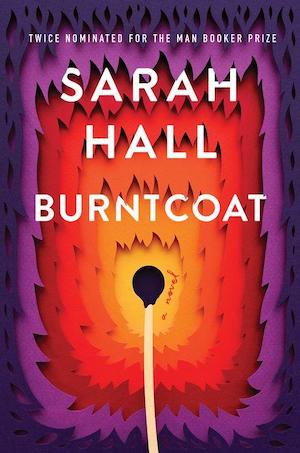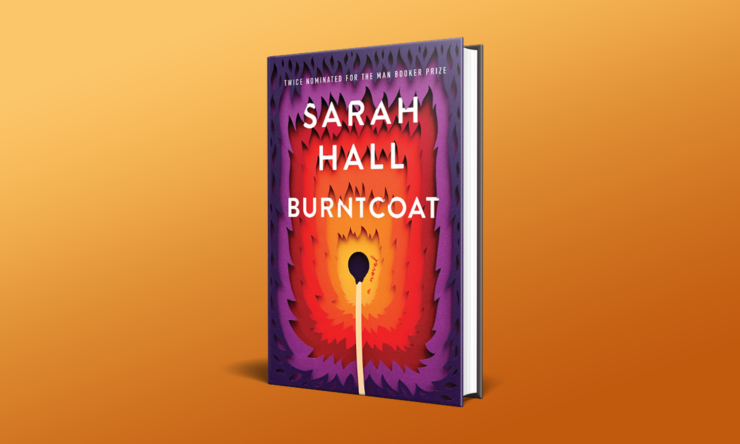“Those who tell stories survive.”
There is no easier way into Sarah Hall’s stellar and devastating Burntcoat than through the first sentence, which the narrator immediately dismantles. As a child, Edith Harkness hears the phrase from her mother, who tends to mix up words and ideas after a hemorrhage in her brain. Isn’t it backwards? Isn’t it that those who survive tell stories? From the vantage point of decades later, Edith wonders: “Do stories make sense of a disordered world? Perhaps Naomi was saying that life is only an invention, a version necessary for us to accept living.”
Edith’s life, her invention, stretches across Burntcoat in timelines that twist and weave. Her other inventions, massive sculptures and art installations, loom over the story as well: a witch at a crossroads, a memorial she may never see. Edith narrates from after a pandemic that has not finished taking things from her.
A year ago, the phrase “pandemic novel” evoked an instant, visceral discomfort that I wanted to shake off, to walk away from. But I would never have guessed that Hall would be one of the first writers to publish a book like this. Along with Gary Shteyngart (Our Country Friends) and Sarah Moss (The Fell) she’s at the edge of this inevitable mini-genre. Reportedly, she began Burntcoat on the first day of lockdown last year.
Hall is prolific, perceptive, impossible to keep up with; I’ve only read (and loved) her novel Daughters of the North, and one short story collection, The Beautiful Indifference, though I ordered most of the rest of her books the minute I put Burntcoat down. She writes with a clarity and precision that keeps her books on the short side, but they are dense with feeling, with perfect observations, and with the physicality of life.
Buy the Book


Burntcoat
And Burntcoat is no exception. In the before times, Edith is an artist living on the edge of town who connects, one night, with the owner of a restaurant she visits with friends. Their relationship begins with drinks that night, tentative and new, and takes bodily shape in the lofty apartment over her workspace. The sex is deliberate as it is disarming; Edith narrates the relationship in the second person, so it is you she’s doing these things with, you whose body she observes.
Who that you is, exactly, is one of the gut-punches of Burntcoat, which has many. It’s a simple story: an artist describes moments of her life—an early relationship gone sour, a period of studying abroad, a new love—as she prepares to finish a new work. But everything is undone by the arrival of a virus just as nasty as the one we’re all now so familiar with.
Hall is wise not to use the actual coronavirus; it gives her the freedom to let the response be a little different, the symptoms a little stranger, the odds worse. But the life she describes, the experience of living in an affluent nation while the world changes shape—it is exact, familiar, crushing. The virus arrives. Edith and Halit, her lover, have little choice: he closes the restaurant, they hole up in her place. Their partnership finds new forms. They discuss their dreams, their work. They drink coffee and wine. Everything is simple. Everything is threatening.
For the first seventy or eighty pages, Burntcoat was a book I was enjoying, lost in Hall’s precise sentences, the way she reflects the world, so familiar but through a lens that seems to slightly shift all the colors. Halit is an immigrant to the UK, and he tells Edith short, defining stories about his family, his former lives. Like her, like all of us, he has been many people—all of them trapped indoors once the virus arrives.
Then the book shifts, developing on a subtle, unnerving intimacy and propulsive urgency. I tried to put it down and do other things, but I needed to know how bad it was going to get, in this nameless British town. I needed to know what Edith was going to live through.
“It is immunity to change that we struggle to accomplish, that seems so inhuman and freeing. Something intrudes, ego, repetitions of the past, or small hard fears, like deposits in the kidney, the breast. The awareness of suffering or desire, hope, an unprovable beyond. I tried these things, but the noise in my head would not stop, would always begin again, on the plane, on the descent from the clouds, every emotion and failing leaking in through the cracks in the air. The body is a wound, a bell ringing in emergency — life, life, life.”
Sometimes people say things like Why do people say they read a book in one sitting, what is that supposed to mean? or Who cares if a book made you cry? What does that tell me about the book? But reading is a physical activity. How you sit, how you move, how often you get up, what physical sensations you have while reading—these can’t be separated from the book that causes them. The book creates them. When I got to the end of Burntcoat I was shaking as if I were sobbing, but there were no tears, just that feeling of being gripped and shaken, everything tied up in knots that take time to relax.
This isn’t just a pandemic novel, if there can even be such a thing as “just” a pandemic novel. Hall positions Edith as a wildly successful artist working in a rare medium—rare for anyone, but especially for a woman. Art school is one of the strands of her life, her apprenticeship another. Her mother is a novelist who doesn’t write for years after her debilitating accident. Her lover creates with food. Everything in Burntcoat is an act of creation, of art, from the way Edith describes Halit’s naked body to the way she builds Burntcoat, her studio, from an abandoned shell of a building. Her work involves burning wood to make it stronger. The metaphor could be too much, but Hall never leans on it. She doesn’t need to. In Edith’s crisp, precise, reserved voice, so many things are perfectly clear.
“It’s a simple exercise, in which we see and read our small, inconsequential lives, and realise we are, in part, curator. It’s all art, even thought, everything is. What we make is made of not only the self but a thousand other naive or rarefied versions.”
Two years ago, this book would have been far more speculative. Now, it’s the everyday, the masks in pockets, the hand sanitizer on every counter, the news, the knowledge that this isn’t over and it isn’t fair. Mortality hovers over every character’s shoulder, just as it does over our own—brighter and more visible, maybe, that it was in the years before.
Burntcoat is available from Custom House.
Molly Templeton lives and writes in Oregon, and spends as much time as possible in the woods. Sometimes she talks about books on Twitter.










